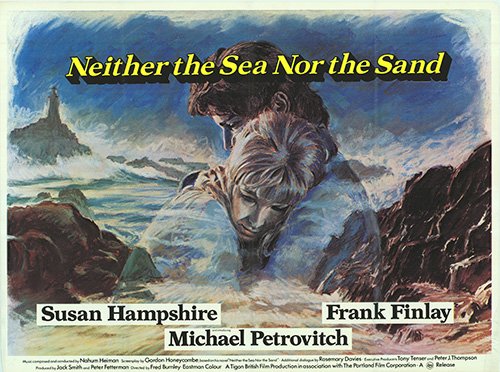 I’ll give this undead romance a verdict of Okay. The film is appealingly offbeat, but as romance it’s pretty inert and only sporadically effective as horror.
I’ll give this undead romance a verdict of Okay. The film is appealingly offbeat, but as romance it’s pretty inert and only sporadically effective as horror.
Although it’s grown quite obscure, the 1969 novel NEITHER THE SEA NOR THE SAND, written by British TV newsreader Gordon Honeycombe, is exemplary horror fiction: touching, grotesque and stubbornly unpredictable. The 1972 film version, faithfully scripted by Honeycombe, is likewise quite obscure, and understandably so. It was shot on location on the Isle of Jersey by television director Fred Burnley (who died three years later), and is now available on DVD courtesy of Britain’s Redemption label. Now if only someone would republish the novel!
The lonely, dissatisfied Annie travels to the Isle of Jersey in an effort to sort out her life. There she meets the dashing lighthouse keeper Hugh, and the two fall in love (despite the fact that Annie is married).
One day Hugh abruptly dies…and comes back as a speechless zombie driven solely by his love for Annie. She’s initially quite happy to see Hugh back among the “living” (they communicate via some kind of telepathy) but finds getting him back to their newfound home quite a task, involving a marathon drive and an arduous trek through an airport and onto a plane.
Annie’s troubles are only beginning. Back home she makes the mistake of summoning Hugh’s gruff brother, who creates loads of trouble. He insists that Hugh is the victim of sorcery and, under Annie’s objections, insists on taking Hugh back to his home so he can put an end to the spell—but Hugh causes his brother’s car to crash in route.
Hugh makes his way back to Annie, who is now stuck with her lover’s rotting undead corpse. But the love that resurrected Hugh still burns in them both, leading to an intense climax in which these two lovebirds make a last-ditch effort to come together in the lighthouse where Hugh once worked, regardless of the forces, supernatural and otherwise, arrayed against them.
Directorially this film is nothing special, burdened as it is with an abundance of annoying seventies conventions. These include several dopey musical montages depicting the main characters frolicking on the beach and having deeply unarousing sex. But the biggest problem is that the lead actors Susan Hampshire and Frank Finlay have little-to-no-chemistry, rendering their supposedly star-crossed love, and by extension the entire first third of the movie (Finlay’s character doesn’t die until about thirty minutes in), moot. Worst of all is Finlay’s somnambulant performance: he acts zombie-like even before his character dies!
Once the supernatural element is introduced the film improves somewhat. The scenic coastal locations make for an effective counterpoint to the horror, and Fred Burnley’s underachieving direction actually works to the film’s advantage in its appealingly understated (however unintentional) tone of muted unease. Burnley embraces neither the gothic melodrama of the English Hammer House of Horror pictures nor the tawdriness of the Italian and American exploiters popular during the early seventies, which is a plus. His film is, in other words, fairly unique, although it would have benefited from a more imaginative treatment.
Vital Statistics
NEITHER THE SEA NOR THE SAND
LMG Film Productions/Portland Film Corporation
Director: Fred Burnley
Producers: Jack Smith, Peter Fetterman
Screenplay: Gordon Honeycombe
(Based on a novel by Gordon Honeycombe)
Cinematography: David Muir
Editing: Norman Wanstall
Cast: Susan Hampshire, Frank Finlay, Michael Petrovitch, Jack Lambert, Michael Craze, David Garth, Anthony Booth, Betty Duncan
